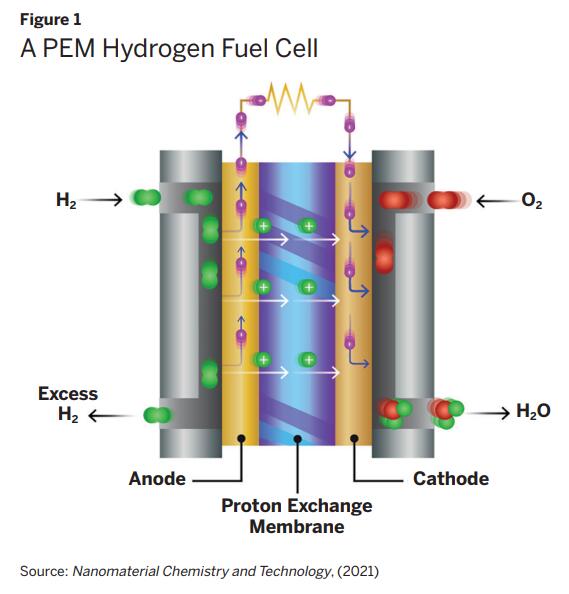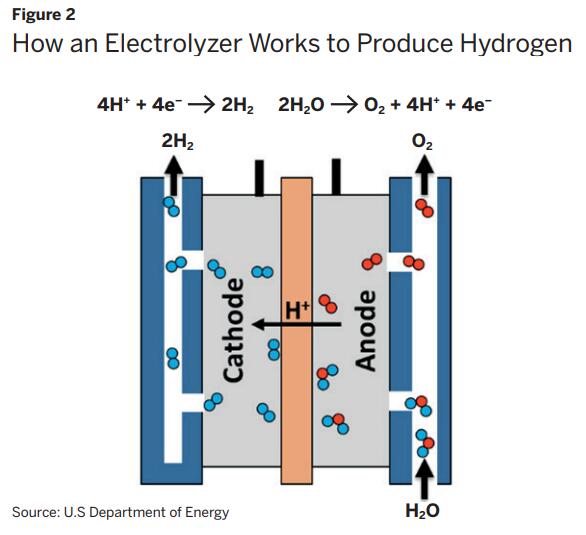Hydrogen Fuel Cells- Q&A Part 1

What are fuel cells?
Fuel cells work much like batteries, using electrochemical reactions to generate electricity. They do not need to be recharged like batteries, but they do need a fuel source to produce electricity. A fuel cell consists of a negative and positive electrode wrapped around an electrolyte. A fuel (such as hydrogen, natural gas, or ammonia) is supplied to the positive electrode, and air is supplied to the negative electrode. A catalyst separates the fuel into protons and electrons, and the electrons go through an external circuit, thus creating a flow of electricity.1
While there are several types of hydrogen fuel cells, the most common type is the polymer electrolyte membrane (PEM) fuel cell (see Figure 1). PEM fuel cells need only hydrogen, oxygen from the air, and water to operate. They are typically fueled with pure hydrogen supplied from storage tanks.2
Fuel cells usually do not produce hydrogen, even though they run on hydrogen fuel. An electrolyzer is needed to produce hydrogen from water; it uses an electric current to split water molecules into oxygen and hydrogen. Like a fuel cell, an electrolyzer also consists of an anode and a cathode separated by an electrolyte (see Figure 2, p. 2). Flexible fuel cells are the only hydrogen fuel cells that can be run in reverse as an electrolyzer, thus generating hydrogen that can be stored and then run through the fuel cell to generate electricity.

What are common uses of fuel cells?
Fuel cells have been used for many years for both transportation applications as well as to generate electricity for buildings.
- Light Use Vehicles: Though several auto manufacturers produce hydrogen fuel cell vehicles for personal use, these vehicles are primarily offered in markets where hydrogen fueling stations already exist, such as in California and Hawaii.3 Without the buildout of additional hydrogen fueling infrastructure, it is unlikely that personal hydrogen fuel cell vehicles will be competitive with battery-powered electric vehicles nationally any time soon.
- Heavy Use Vehicles: The energy density of hydrogen makes hydrogen fuel cells a good option for decarbonizing heavy-duty vehicles such as trucks, buses, and forklifts. The refueling time and driving range of a hydrogen fuel cell heavy-duty vehicle is comparable to that of a gasoline powered truck, and these vehicles often have predictable routes, making it easier to concentrate the buildout of hydrogen fueling stations.4
- Shipping: Using hydrogen or ammonia fuel cells for shipping is still relatively new, but early studies show that this is a promising concept for decarbonizing longdistance shipping routes. Recent studies show that 99 percent of container ship voyages in the corridor between China and the United States—the busiest shipping corridor in the world—could be powered by hydrogen fuel cells with only minor changes to fuel capacity or operations, such as adding one additional port of call to refuel.5
- Short-Haul Air Travel: Hydrogen’s energy density also makes it a good option for decarbonizing short-haul air travel. A large hydrogen fuel cell stack can power propulsion and on-board operations for most regional flights. Aircraft manufacturer Airbus has stated that research and development is underway to produce a fully decarbonized aircraft for longer duration travel by 2035.6 It should be noted that some hydrogen-powered aircraft combust hydrogen for propulsion, which is not emissions-free. Hydrogen is only emissions-free when run through a fuel cell.
- Microgrids: Hydrogen’s ability to be generated and stored on-site can make it a valuable addition to a microgrid for energy users who cannot risk an interruption in power. One such example is a public housing complex in Vårgårda, Sweden, which installed 5,400 square feet of solar PV. The electricity generated by the solar is first used to fill a battery, and then the remainder is run through an electrolyzer to generate green hydrogen. This hydrogen is then stored onsite to fuel six 5-kilowatt fuel cells, one in each building of the complex, in the event the battery runs out of electricity. This hybrid model, using both battery storage and fuel cells, can reduce the costs and improve the efficiency of developing a fuel cell microgrid.

1 U.S. Dept. of Energy, “Fuel Cells,” Energy.gov, https://www.energy.gov/eere/fuelcells/fuel-cells (accessed September 1, 2021).
2 U.S. Dept. of Energy, “Types of Fuel Cells,” Energy.gov, https://www.energy.gov/eere/fuelcells/types-fuel-cells (accessed September 27, 2022),
3 U.S. EPA, “Hydrogen Fuel Cell Vehicles,” epa.gov, last updated September 13, 2022, https://www.epa.gov/greenvehicles/hydrogen-fuel-cell-vehicles (accessed September 27, 2022).
4 Eberle, Ulrich and Rittmar von Helmolt, “Sustainable Transportation Based on Electric Vehicle Concepts: A Brief Overview,” Energy & Environmental Science, Issue 6, (2010): 689, https://doi.org/10.1039/C001674H (accessed September 27, 2022).
5 Mao, Xiaoli, Dan Rutherford, Liudmila Osipova, and Brian Comer, “Refueling Assessment of a Zero-Emission Container Corridor between China and the United States: Could Hydrogen Replace Fossil Fuels?” TheICCT.org, March 3, 2020, https://theicct.org/publication/refueling-assessment-of-a-zeroemission-container-corridor-between-china-and-the-united-states-could-hydrogen-replace-fossil-fuels (accessed September 27, 2022).
6 Airbus, “The Green Hydrogen Ecosystem for Aviation, Explained,” Airbus.com, June 17, 2021, https://www.airbus.com/en/newsroom/news/ 2021-06-the-green-hydrogen-ecosystem-for-aviation-explained (accessed September 27, 2022). 7 U.S. Dept. of Energy, “Fuel Cell Animation (Text Version),” Energy.gov, https://www.energy.gov/eere/fuelcells/fuel-cell-animation-text-version (accessed August 25, 2022)
Source: Hydrogen Fuel Cells ANSWERS TO FOUR COMMON QUESTIONS, https://www.cleanegroup.org/wp-content/uploads/Hydrogen-Fuel-Cell-Fact-Sheet.pdf
